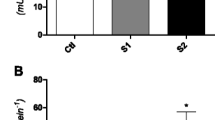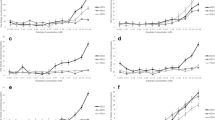Abstract
Monitoring of acetylcholinesterase (EC: 3.1.1.7, AChE) activity has been widely used in aquatic and terrestrial systems as an indicator of pollutant exposure. The reports regarding impact of fertilizer industry effluent on the level of AChE activity are very scanty. In this paper, an attempt has been made to investigate the in vitro impact of fertilizer industry effluent upon the levels of AChE activity and protein content in different tissues of non-target aquatic fish, Channa striatus (Bloch). The fish when exposed to three sublethal concentrations (3.5, 4.7, and 7.0%; v/v) of fertilizer industry effluent for short (96 h) and long (15 days) durations registered sharp reduction in the levels of AChE activity (15–75%) and protein (10–71%) in different fish organs. The highest effluent concentration treatment for short or long duration, the fish brain and gills registered significant (P < 0.001) inhibition (64–75%) in the activity of AChE whereas other organs such as muscles, liver, and heart exhibited slightly lower inhibition (40–59%) in enzyme activity. However, kidney of C. striatus was the only organ where very less effect (14–18%) of the effluent was observed on the activity of AChE when the fish were exposed to all the three concentrations of the effluent for both treatment durations. This effluent also induced alterations in the level of protein in different fish organs; in kidney the effect was pronounced only at higher concentrations at both treatment durations. The most affected organs were muscle and gills where in 60–71% reduction in the protein content was recorded due to highest effluent concentration treatment at short or long durations. The results of present study indicated that the fertilizer industry effluents might significantly influence the neurotransmission system and protein turnover in the non-target organisms after exposure even at very low concentrations. Further, the data suggested that the fish AChE could be used as a potential biochemical marker for fertilizer industry effluent pollution in aquatic systems.
Similar content being viewed by others
References
Abarnou A, Burgeot T, Chevreuil M, Leboulenger F, Loizeau V, Madoulet-Jaouen A, Minier C (2000) Les contaminants organiques: quels risques pour le monde vivant? Programme Scientifique Seine Aval 13. Ifremer, Paris
Adham KG (2002) Sublethal effect of aquatic pollution in Lake Maryut on the African sharptooth catfish, Clarias garipinus (Burchell, 1822). J Appl Ichthyol 18:87–94. doi:10.1046/j.1439-0426.2002.00337.x
APHA/AWWA/WPCF (1975) Standard methods for the examination of water and wastewater, 14th edn. American Public Health Association/American water work association/water pollution control federation, Washington, DC
Ausley LW (2000) Reflections on whole effluent toxicity: the Pellstone workshops. Environ Toxicol Chem 19:1–2. doi:10.1897/1551-5028(2000)019<0001:ROWETT>2.3.CO;2
Bobmanuel NOK, Gabriel UU, Ekweozor IKE (2006) Direct toxic assessment of treated fertilizer effluents to Orechromis niloticus, Clarias gariepinus and catfish hybrid (Heterobranchus bidorsalis(male) × Clarias gariepinus(female)). Afr J Biotechnol 5(8):635–642
Bocquené G, Bellanger C, Cadiou Y (1995) Joint action of combinations of pollutants on the acetylcholinesterase activity of several marine species. Ecotoxicology 4:266–279. doi:10.1007/BF00116345
Bocquene G, Galgani F, Truquet P (1990) Characterization and assay conditions for use of AChE activity from several marine species in pollution monitoring. Marine species in pollution monitoring. Mar Environ Res 30:75–89. doi:10.1016/0141-1136(90)90012-D
Chapman PM (2000) Whole effluent toxicity testing—usefulness, level of protection and risk assessment. Environ Toxicol Chem 19:3–19. doi:10.1897/1551-5028(2000)019<0003:WETTUL>2.3.CO;2
Chen C-J, Liao S-L (2003) Zinc toxicity on neonatal cortical neuron: involvement of glutathione chelate. J Neurochem 85:443–453. doi:10.1046/j.1471-4159.2003.01691.x
Chiffoleau JF, Gonzalez JL, Miramand P, Thouvenin B (1999) Le cadmium, comportement d’un contaminant métallique en estuaire. Programme Scientifique Seine Aval, 10. Ifremer, Paris
Chukwu LO (1993) Evaluation of pollutant load of WEMABOD treated industrial effluent, Lagos. Nig J Biotechnol 11:142–147
De la Torre FL, Ferrari R, Salibian A (2002) Freshwater pollution biomarker: response of brain acetylcholinesterase activity in two fish species. Comp Biochem Physiol Toxicol Pharmacol 131(3):271–280. doi:10.1016/S1532-0456(02)00014-5
Effiok BJ (1993) Basic calculations for chemical and biological analyses. AOAC, Baltimore, p 150
Ekweozor IKE, Bobmanuel NOK, Gabriel UU (2001) Sublethal effect of ammonical fertilizer effluents on three commercial fish species from Niger Delta Area, Nigeria. J Appl Sci Environ Mang 5(1):63–68
Ellman GL, Courtney D, Andres V Jr, Featherstone RM (1961) A new and rapid colorimetric determination of acetylcholinesterase activity. Biochem Pharmacol 7:88–96. doi:10.1016/0006-2952(61)90145-9
Engel DW, Sundu WG, Fowler BA (1981) Factor effecting trace metal uptake and toxicity to estuarine organisms. Academic Press, London
Escartin E, Porte C (1997) The use of cholinesterase and carboxylesterase activities from Mytilus galloprovincialis in pollution monitoring. Environ Toxicol Chem 16:2090–2095. doi:10.1897/1551-5028(1997)016<2090:TUOCAC>2.3.CO;2
Federal Environmental Protection Agency (FEPA) Regulations (1991) Abuja: S.1.8 effluent and S.1.9 pollution abatement in industries and facilities generating wastes
Forget J, Pavillon JF, Beliaeff B, Bocquene G (1999) Joint action of pollutant combinations (pesticides and metals) on survival (LC50 values) and acetylcholinesterase activity of Tigriopus brevicornis (Copepoda, harpacticoida). Environ Toxicol Chem 18:912–918. doi:10.1897/1551-5028(1999)018<0912:JAOPCP>2.3.CO;2
Fulton MH, Key PB (2001) Acetylcholinesterase inhibition in estuarine fish and invertebrates as an indicator of organophosphorus insecticide exposure and effects. Environ Toxicol Chem 20:37–45. doi:10.1897/1551-5028(2001)020<0037:AIIEFA>2.0.CO;2
Gaitonde D, Sarkar A, Kaisary S, Silva CD, Dias C, Rao DP, Ray D, Nagarjan R, De sousa SN, Sarker S, Patill D (2006) Acetylcholinesterase activities in marine snail (Cronia contracta) as a biomarker of neurotoxic contaminants along the Goa coast, West coast of India. Ecotoxicology 15(4):353–358. doi:10.1007/s10646-006-0075-3
Kirby MF, Morris S, Hurst M, Kirby SJ, Neall P, Tylor T, Fagg A (2000) The use of cholinesterase activity in flounder (Platichthys flesus) muscle tissue as a biomarker of neurotoxic contamination in UK estuaries. Mar Pollut Bull 40:780–791. doi:10.1016/S0025-326X(00)00069-2
Kopecka J, Lehtonen KK, Barsiene J, Broeg K, Vuorinen PJ, Gercken J, Pempkowiak J (2006) Measurement of biomarker levels in flounder (Platichthys flesus) and blue mussel (Mytilus trossulus) from the Gulf of Gdansk (southern Baltic). Mar Pollut Bull 53:406–421. doi:10.1016/j.marpolbul.2006.03.008
Kupechella CE, Hyland MC (1989) Environmental science. Allyn and Baron, London
Lionetto MG, Caricato R, Giordano ME, Pascariello MF, Marinosci L, Schettino T (2003) Integrated use of biomarkers (acetylcholinesterase and antioxidant enzymes activities) in Mytilus galloprovincialis and Mullus barbatus in an Italian coastal marine area. Mar Pollut Bull 46(3):324–330. doi:10.1016/S0025-326X(02)00403-4
Lloyd R (1992) Pollution and freshwater fish. Fishing-news books. Division of Blackwell Scientific Publications, Ltd, UK, p 176
Lorz HW, McPherson BP (1976) Effects of copper or zinc in fresh water on the adaptation to seawater and ATPase activity and the effects of copper on migratory disposition of coho salmon (Oncorhynchus kisutch). J Fish Res Board Can 33:2023–2030
Lowry OH, Rosebrough NJ, Farr AL, Randel RJ (1951) Protein measurement with folin-phenol reagent. J Biol Chem 192:265–275
Matthiessen P, Thain J, Law RJ, Fileman TW (1993) Attempts to assess the environmental hazard posed by complex mixtures of organic chemicals in UK estuaries. Mar Pollut Bull 26:90–95. doi:10.1016/0025-326X(93)90097-4
Najimi S, Bouhaimi A, Daubèze M, Zekhnini A, Pellerin J, Narbonne JF, Moukrim A (1997) Use of acetylcholinesterase in Perna perna and Mytilus galloprovincialis as a biomarker of pollution in Agadir marine bay (South of Morocco). Bull Environ Contam Toxicol 58(6):901–908. doi:10.1007/s001289900419
Nussey G (1998) Metal ecotoxicology of the upper Olifants river at selected localities and the effect of copper and zinc on fish blood physiology. Ph.D. thesis, RAU
Obodo GA (2002) The bioaccumulation of heavy metals in fish from the lower reaches of river Niger. J Chem Soc Niger 27(2):173–176
Ojuola FA, Onuoha GC (1987) The effect of liquid petroleum refinery effluent on fingerlings of Sarotherodon melanotheron (Ruppel 1852) and Oreochromis niloticus (Linn. 1757). Aquaculture working paper ARAC/87/WP, 8
Parvez S, Raisuddin S (2005) Protein carbonyls: novel biomarkers of exposure to oxidative stress inducing pesticides in freshwater fish Channa punctata Bloch. Environ Toxicol Pharmacol 20:112–117. doi:10.1016/j.etap.2004.11.002
Payne JFA, Mathieu WM, Fancey LL (1996) Acetylcholinesterase, an old biomarker with a new future. Field trilas in association with two urban rivers and a paper mill in Newfoundland. Mar Pollut Bull 32:225–231
Ramakritinan CM, Kumaraguru AK, Balasubramanian MP (2005) Impact of distillery effluent on carbohydrate metabolism of freshwater fish, Cyprinus carpio. Ecotoxicology 14:693–707. doi:10.1007/s10646-005-0019-3
Rand GM, Petrocelli SM (1984) Fundamentals of aquatic toxicology methods and applications. McGraw-Hill International Book Company, New York, p 666
Roger TD (1980) Mechanism and regulation of protein degradation in animal cells. In: Clemens HJ, Ashwell M (eds) Biochemistry of cellular regulation, vol 2. CRS Press, Florida, pp 101–122
Sarkar A, Ray D, Shrivastava AN, Sarker S (2006) Molecular biomarkers: their significance and application in marine pollution monitoring. Ecotoxicology 15(4):333–340
Scholz NL, Truelove NK, Labenia JS, Baldwin DH, Collier TK (2006) Dose-additive inhibition of chinook salmon acetylcholinesterase activity by mixtures of organophosphate and carbamate insecticides. Environ Toxicol Chem 25(5):1200–1207. doi:10.1897/05-030R1.1
Sharma B (1999) Effect of carbaryl on some biochemical constituents of the blood and liver of Clarias batrachus, a fresh water fish. J Toxicol Sci 24:157–164
Singh RK, Sharma B (1998) Carbofuran induced biochemical changes in Clarias batrachus. Pestic Sci 53:285–290. doi:10.1002/(SICI)1096-9063(199808)53:4<285::AID-PS771>3.0.CO;2-0
Singh RK, Sharma B (2004) In vivo alteration in protein metabolism by subacute carbofuran intoxication in the freshwater teleost, Clarias batrachus. Bull Environ Contam Toxicol 73(5):919–926. doi:10.1007/s00128-004-0514-x
Singh RK, Sharma B (2005) Sub-acute toxicity of carbofuran on acetylcholinesterase activity in the freshwater catfish, Clarias batrachus. J Environ Occup Med 22(5):403–407
Singh RK, Singh RL, Sharma B (2003) Acute toxicity of carbofuran to a freshwater teleost, Clarias batrachus. Bull Environ Contam Toxicol 70(6):1259–1263. doi:10.1007/s00128-003-0118-x
Tamburlini G, Ehrenstein OV, Bertollini R (2002) Children’s health and environment: a review of evidence. In: Environmental issue report no. 129, WHO/European Environment Agency, WHO Geneva, 223
Thurston RV, Russo TL, Smith CE (1978) Acute toxicity of ammonia and nitrate to cutthroat fry. Trans Am Fish Soc 107:361–368. doi:10.1577/1548-8659(1978)107<361:ATOAAN>2.0.CO;2
Tilak KS, Vereraiah K, Rao DK (2005) The effect of chloropyrifos, an organophosphate in acetylcolinestrase activity in fresh water fishes. J Environ Biol 26(1):73–78
Tripathi G, Verma P (2004) Endosulfan-mediated biochemical changes in the fresh water Clarias batrachus. Biomed Environ Sci 17(1):47–56
Valarmathi S, Azariah J (2003) Effect of copper chloride on the enzyme activities of the Crab, Sesarma quadratum (Fabricius). Tark J Biol 27:253–256
Wepener V, Van Vuren JHJ, Du Preez HH (2001) Uptake and distribution of a copper, iron and zinc mixturein gill, liver and plasma of a freshwater teleost, Tilapia sparmanii. Water SA 27(1):99–108
WHO (2002) Water pollutants. Biological agents, dissolved chemicals, non-dissolved chemicals, sediments, heat. WHO CEHA, Amman
Williams AK, Sova RC (1966) Acetylcholinesterase levels in brains of fishes from polluted waters. Bull Environ Contam Toxicol 1:198–204. doi:10.1007/BF01684097
Yadav A, Gopesh A, Pandey RS, Rai DK, Sharma B (2007) Fertilizer industry effluent induced biochemical changes in freshwater teleost Channa striatus (Bloch). Bull Environ Contam Toxicol 79:588–595. doi:10.1007/s00128-007-9294-4
Yadav A, Neraliya S, Singh R (2005) Effect of fertilizer industrial effluent on the behavior and morphology of fresh water catfish, Heteropeneustes fossilis (Bloch). Proc Nat Acad Sci India 75(B)(111):191–195. http://nasi.nic.in/proc_B_3_2005.htm
Yadav A, Singh RK, Sharma B (1998) Interaction of carbofuran with acetylcholinesterase from the brain of the teleost, Clarias batrachus. Toxicol Environ Chem 65:245–254. doi:10.1080/02772249809358574
Acknowledgments
The authors express their gratitude to Professor Pratima Gaur, Head, Department of Zoology, University of Allahabad, Allahabad, for providing basic facilities for carrying out the present research work. The central research facility developed at the Department of Zoology with the help of financial assistance obtained from UGC-SAP and DST-FIST was utilized in this study
Author information
Authors and Affiliations
Corresponding author
Rights and permissions
About this article
Cite this article
Yadav, A., Gopesh, A., Pandey, R.S. et al. Acetylcholinesterase: a potential biochemical indicator for biomonitoring of fertilizer industry effluent toxicity in freshwater teleost, Channa striatus . Ecotoxicology 18, 325–333 (2009). https://doi.org/10.1007/s10646-008-0286-x
Accepted:
Published:
Issue Date:
DOI: https://doi.org/10.1007/s10646-008-0286-x




